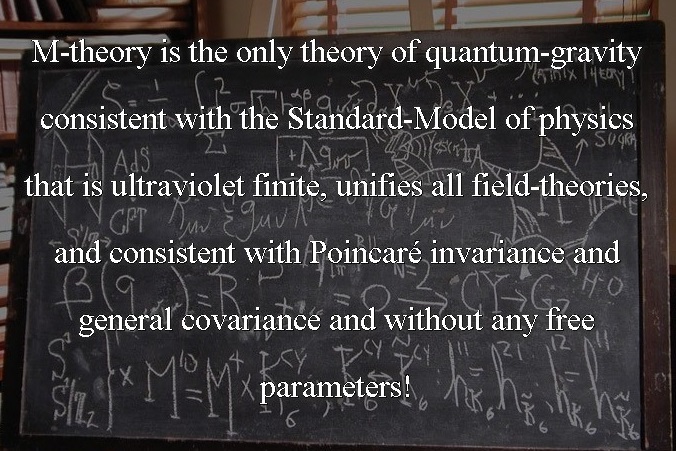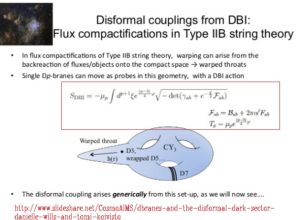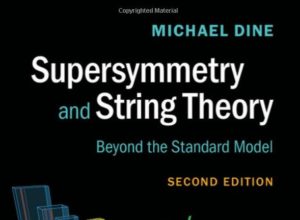Here, I will demonstrate how M-theory implies that the string worldsheet quantum theory ‘knows’ all about four-dimensional physics. Start with the Dp-action:
![Rendered by QuickLaTeX.com \[S_p^D = \, - {T_p}\int\limits_{{\rm{worldvolumes}}} {{d^{p + 1}}} \xi \frac{{\not D_{\mu \nu }^{susy}L}}{{{{\not \partial }_{{v_a}}}}}{e^{ - {\Phi _{bos}}}}{\rm{de}}{{\rm{t}}^{1/2}}G_{ab}^{\exp \left( {H_{p + 1}^{{\rm{array}}}} \right)}\]](https://www.georgeshiber.com/wp-content/ql-cache/quicklatex.com-3ee868f0f83c3f66855aa2539b9a4822_l3.png)
4-dimensionality entails that the mass of a Dp-brane can be derived as:
![Rendered by QuickLaTeX.com \[{T_p}{e^{ - {\Phi _{bos}}}}\prod\limits_{i = 1}^p {\left( {2\pi nR} \right)} \]](https://www.georgeshiber.com/wp-content/ql-cache/quicklatex.com-3c2f43a024963feed958e11d0d7d3fbf_l3.png)
and by T-dualizing in the
![]()
direction and factoring the dilaton, the dual is hence:
![Rendered by QuickLaTeX.com \[\begin{array}{c}({T_p}\left( {2\pi \sqrt {\alpha '} } \right){e^{ - {\Phi _{bos}}}}\prod\limits_{i = 1}^{p - 1} {\left( {2\pi {R_p}} \right)} = \\{T_{p - 1}}{e^{ - \Phi _{bos}^{1/2}}}\prod\limits_{i = 1}^{p - 1} {\left( {2\pi {R_{p - 1}}} \right)} \end{array}\]](https://www.georgeshiber.com/wp-content/ql-cache/quicklatex.com-8810308c79381bf0f22ba417dce0c20b_l3.png)
By matrix world-volume integral reduction on
![Rendered by QuickLaTeX.com \[S_p^D = \, - {T_p}\int\limits_{{\rm{worldvolumes}}} {{d^{p + 1}}} \xi \frac{{\not D_{\mu \nu }^{susy}L}}{{{{\not \partial }_{{v_a}}}}}{e^{ - {\Phi _{bos}}}}{\rm{de}}{{\rm{t}}^{1/2}}G_{ab}^{\exp \left( {H_{p + 1}^{{\rm{array}}}} \right)}\]](https://www.georgeshiber.com/wp-content/ql-cache/quicklatex.com-3ee868f0f83c3f66855aa2539b9a4822_l3.png)
the Polyakov action for the string is hence:
![]()
with ![]() the embedding of the string in target space,
the embedding of the string in target space, ![]() the worldsheet metric, and
the worldsheet metric, and ![]() the spacetime metric.
the spacetime metric.
Now, the variation, through all Einstein-indices, of the action with respect to ![]() is then:
is then:
![]()
with
![]()
and with equation of motion (EOM):
![]()
after taking the determinant, the following holds:
![]()
and inserting into the Polyakov action yields:
![]()
with ![]() the Nambu-Goto action for the string:
the Nambu-Goto action for the string:
![]()
hence, the functional derivative of the Polyakov Lagrangian with respect to the derivative of the dynamical field is
![]()
giving us the Euler-Lagrange equations:
![]()
Thus, the strings obey a wave equation
as can be seen by the Laplacian equation:
![Rendered by QuickLaTeX.com \[\left\{ {\begin{array}{*{20}{c}}{{\nabla ^2}{X^\mu } = 0}\\{{\nabla ^2}f \equiv \frac{1}{{\sqrt \gamma }}{{\not \partial }_a}\left( {\sqrt \gamma {\gamma ^{ab}}{{\not \partial }_b}f} \right)}\end{array}} \right.\]](https://www.georgeshiber.com/wp-content/ql-cache/quicklatex.com-bdf312d16600bb76ecfc8f6d65c9ff29_l3.png)
It follows then that the renormalization Lie-equation for the sigma-model on the string worldsheet entails
![]()
So, from
![Rendered by QuickLaTeX.com \[\begin{array}{c}({T_p}\left( {2\pi \sqrt {\alpha '} } \right){e^{ - {\Phi _{bos}}}}\prod\limits_{i = 1}^{p - 1} {\left( {2\pi {R_p}} \right)} = \\{T_{p - 1}}{e^{ - \Phi _{bos}^{1/2}}}\prod\limits_{i = 1}^{p - 1} {\left( {2\pi {R_{p - 1}}} \right)} \end{array}\]](https://www.georgeshiber.com/wp-content/ql-cache/quicklatex.com-8810308c79381bf0f22ba417dce0c20b_l3.png)
the Einstein vacuum field equation is encoded in the quantum structure of the worldsheet theory as characterized by
![]()
with ![]() satisfying:
satisfying:
Therefore, the β-function equation gives a definition of the stress-energy tensor for the worldsheet theory
![]()
with
![]()
By holographic renormalization, it follows that the worldsheet quantum theory knows all about 4-D spacetime physics
as attested by
![Rendered by QuickLaTeX.com \[\frac{d}{{{d_{{\sigma _p}}}}}\int\limits_{{\rm{worldvolumes}}}^p {{e^{H_{p + 1}^{{\rm{array}}}}}} + \underbrace {\sum\limits_{{\sigma _p}}^D {{{\left( {S_p^D} \right)}^{ - H_{p + 1}^{{\rm{array}}}}}} }_{{\rm{topologies}}}\]](https://www.georgeshiber.com/wp-content/ql-cache/quicklatex.com-eac6615751f3de7e728719e91821ec83_l3.png)





